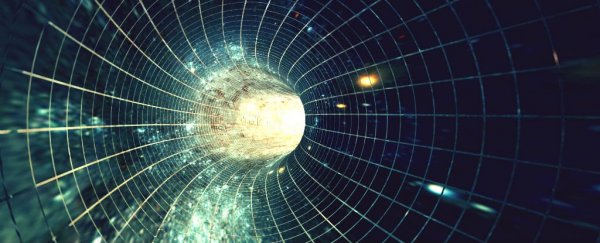A team of theoretical physicists has a mind-bending new explanation for why our Universe is the way it is, and how it emerged in all its strangeness.
According to a recent paper, space-time itself - the very fabric that makes up our Universe - is nothing more than a product of quantum mechanics. And distortions in this quantum 'weirdness' can explain why strange phenomena such as entanglement and quantum tunnelling arise.
It sounds pretty out there, but the idea is actually built upon several previous hypotheses. In fact, it could fundamentally link the two biggest theories in physics - general relativity and quantum mechanics.
Which means we would finally get the much-desired quantum gravity 'theory of everything' that physicists have been lusting after for decades.
"If one accepts that gravitational phenomena like the formation of planetary systems, galaxies or even black holes, have the very same origin as entanglement and the tunnel effect - indeed that gravity is quantum - then an unification between quantum physics and gravity may be at reach," one of the researchers behind the study, Paulo Castro from the University of Lisbon in Portugal, told ScienceAlert in an exclusive interview.
But before we get ahead of ourselves, let's break down what's going on here.
For anyone who's ever laid awake at 3 am wondering what the Universe is actually made of, you are probably aware that the answer, to the best of our knowledge, is space-time.
Space-time is the strange fabric that merges the three dimensions of space and the one dimension of time we experience in our reality, and turns it into the theoretical backdrop of the Universe.
To put it in a less ethereal way, when gravitational waves ripple out from a massive collision of black holes, it's space-time they ripple through.
In fact, according to Einstein's general theory of relativity, gravity is actually a feature of space-time, created when its curved by massive objects such as the Sun or Earth.
So far, so good. But here's the problem. While general relativity has gravity sorted out, quantum mechanics has never been able to fully explain the force.
And that's not even mentioning the other strange phenomena that we now have evidence for but can't quite explain - such as quantum entanglement and quantum tunnelling, where information appears to travel faster than the speed of light. How do they fit in with general relativity?
That brings us back to this recent paper.
According to the new theory by Castro and his team, the origins of space-time could hold the answer.
"In general relativity, space-time pre-exists like a tridimensional foldable substance and whatever happens in the world happens inside it," says Castro. "The possible trajectories of all objects and their velocities are determined by the way very large masses, like planets or stars, fold space-time. This is what gravity is."
"In our proposal, space-time does not pre-exist, it is the result of a physical process by which the subquantum medium goes from a chaotic state to a more organised one."
This subquantum medium is something that Castro describes as "a kind of primordial foam from where space-time itself emerges".
You could think of it like a quantum miso soup: initially it's all stirred up, and nothing can be distinguished from the chaos. But as the soup settles and becomes more 'organised', structures begin to emerge.
"In fact, in our theory, these organised states correspond to subquantum waves, imposing how space and time behaves, giving rise to extreme cases, like the ones in entanglement and the tunnel effect," says Castro.
"As space-time different behaviours are, of course, signatures of gravity, you can now say that gravity is quantum."
For now this is all purely theoretical, but the researchers are working on ways to test their ideas.
One idea they have in mind involves the strange 'quantified' pattern seen in the placement of planets in our Solar System, which the researchers previously suggested hinted at the existence of stationary subquantum waves around our Sun.
If they could confirm that, it might help give more weight to their latest theory.
That's a long way off, but it's a pretty exciting starting point for further calculations and thought experiments.
After all, the Universe is filled with countless phenomena we can't explain - and more are added to the list frequently.
While many researchers argue that 'new physics' is needed to explain what's going on, it's comforting to think that we could make a little more sense of our reality just by rethinking and re-evaluating our existing models.
Watch this space.
The research was published in the Journal of Applied Mathematics and Physics.
